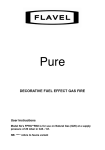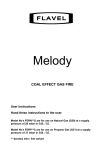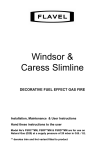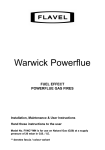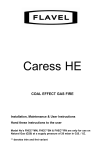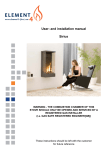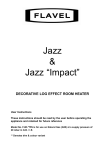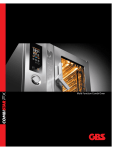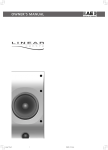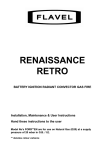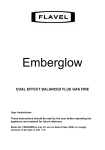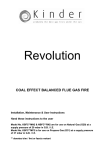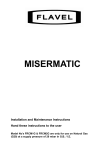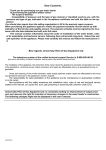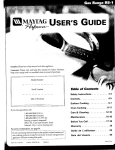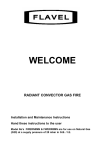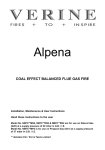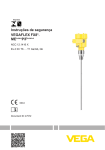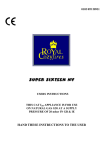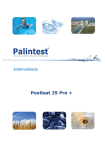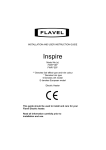Download Vesta Installation & User Manual
Transcript
Vesta INSET FUEL EFFECT GAS FIRE Installation, Maintenance & User Instructions Hand these instructions to the user following installation Model No’s FVTC**MN, FVTP**MN, FVTC**RN & FVTP**RN are only for use on Natural Gas (G20) at a supply pressure of 20 mbar in G.B. / I.E. ** denotes colour variant Section 1 1.0 1.1 1.2 1.3 1.4 1.5 1.6 1.7 1.8 1.9 1.10 1.11 4.1 4.2 4.3 4.4 4.5 4.6 4.7 4.8 11 11 12-19 20 20 Assembling Fuel Bed and Commissioning 21-25 26-29 30 31 31-33 33 Maintenance Removal Removal Removal Removal Removal Removal Removal Removal Section 5 5.1 5.2.1 5.2.2 5.2.3 5.3 5.4 5.5 5.6 5.7 5.8 Installation of Fire Assembling the ceramics and fuel bed (coal models) Assembling the ceramics and fuel bed (pebble models) Fitting the Fascia Lighting the appliance (MC Models) Lighting the appliance (RC Models) Checking for clearance of combustion products Section 4 PAGE 3 4 4 4 5 5 6 8 8 8 9 10 Unpacking the fire Installing the Firebox Preparation of Firebox Opening Gas tightness and burner pressure (MC Models) Gas tightness and burner pressure (RC Models) Section 3 3.1 3.2 3.3 3.4 3.5 3.6 Information and Requirements Appliance Information Conditions of Installation Flue and chimney suitability Fireplace / surround suitability Shelf position Chimney inspection Fire place opening / catchment space Fitting to Chair bricks Precast Flues Metal Flue boxes Wall / Hearth Mounting Spillage Monitoring System Section 2 2.1 2.2 2.3 2.4 2.4 CONTENTS of of of of of of of of the the the the the the the the Burner Assembly (Manual) Piezo Igniter Control Tap Pilot Assembly Burner Assembly (Remote) RC Valve Pilot Assembly Batteries in the IR Reciever 34 35 35 35 36 36 36-37 37 User Instructions Conditions of Installation Operating the Fire (MC models) Operating the Fire (RC models) Spillage Monitoring System Re-Assembling the fuel-bed (coal models) Re-Assembling the fuel-bed (pebble models) Cleaning the Fire Cleaning the Fuel-bed Removal & Re-Fitting the Fascia User Replaceable Parts 39 41 42-43 43 44-48 49-52 52 52 53 53 This appliance is manufactured by :- BFM Europe Ltd, Trentham Lakes, Stoke-on-Trent, ST4 4TJ 2 SECTION 1 INFORMATION AND REQUIREMENTS 1.0 APPLIANCE INFORMATION Model FVTC**MN, FVTP**MN, FVTC**RN & FVTP**RN G20 Gas Type Main injectors (2 off) Pilot Type Size 235 S.I.T. Oxystop YA OP 9022 (MC & RC) Max. Gross Heat Input : Min. Gross Heat Input : 6.5 kW 4.2 kW Cold Pressure : Cold Pressure : FVTC / P**MN - 20.0 +/-1.0 mbar FVTC / P**RN - 20.0 +/-1.0 mbar Ignition : Push-button Piezo (Manual models) 6V Battery Generator (Remote models) Electrode Spark Gap Weight 4.0mm All models MC 19 Kg, RC 20kG Fire box Dimensions (with fascia fitted) Width : Height : Depth : Depth : (with fascia fitted) (with fascia fitted) (overall-with fascia) (from mounting face) Gas Connection Efficiency Declaration 753mm 559mm 198mm 70mm 8mm Compression (Supplied with fire) The efficiency of this appliance has been measured as specified in BS 7977-1 : 2002 and the result is 55%. The gross calorific value of the fuel has been used for this efficiency calculation. The test data from which it has been calculated has been certified by Advantica. The efficiency value may be used in the UK Government’s Standard Assessment Procedure (SAP) for energy rating of dwellings. 3 INSTALLATION REQUIREMENTS 1.1 CONDITIONS OF INSTALLATION It is the law that all gas appliances are installed only by a CORGI Registered Installer, in accordance with these installation instructions and the Gas Safety (Installation and Use) Regulations 1998 as amended. Failure to install appliances correctly could lead to prosecution. It is in your own interest and that of safety to comply with the law. The installation must also be in accordance with all relevant parts of the Local and National Building Regulations where appropriate, the Building Regulations (Scotland Consolidation) issued by the Scottish Development Department, and all applicable requirements of the following British Standard Code of Practice. 1. 2. 3. 4. 5. 6. 7. BS 5871 Part 2 Installation of Inset Live Fuel Effect Gas Fires BS 6891 Installation of Gas Pipework BS 5440 Parts 1 & 2 Installation of Flues and Ventilation BS 1251 Open fire place components BS 715 / BS EN 1856-2 Metal flue pipes for gas appliances BS EN 1858 Clay Flue Blocks and Terminals IS 813 : 1996 Domestic Gas Installation (Republic of Ireland) No purpose made additional ventilation is normally required for this appliance, when installed in G.B. When Installing in I.E. please consult document I.S. 813 : 1996 Domestic Gas Installation, which is issued by the National Standards Authority of Ireland. If installing in Northern Ireland, please consult local building regulations. Any purpose made ventilation must be checked periodically to ensure that it is free from obstruction. 1.2 FLUE AND CHIMNEY SUITABILITY This appliance is designed for use with conventional brick built or lined chimneys and fabricated flues and metal flue boxes conforming to BS 715 / BS EN 1856-2. All flues must conform to the following minimum dimensions. Minimum diameter of circular flues Minimum effective height of all flue types 125 mm (Without Flue Restrictor Fitted) 3 metres When fitting to conventional chimneys or 175mm flues it may be desirable to fit the flue restrictor baffle (supplied) to reduce the flue flow and increase the efficiency of the fire. Safe clearance of products must always be checked by carrying out a smoke match test as described. 4 1.3 FIREPLACE / SURROUND SUITABILITY The fire must not be installed directly onto carpet or other combustible floor materials. See page 9 for further details regarding hearth panels. The fire is suitable for fitting to non-combustible fire place surrounds and proprietary fire place surrounds with a temperature rating of at least 150oc. If a heating appliance is fitted directly against a wall without the use of a fire surround or fire place all combustible material must be removed from behind the trim. Soft wall coverings such as blown vinyl, wall paper etc. could be affected by the rising hot air and scorching and/or discoloration may result. Due consideration should be made to this when installing or decorating. 1.4 SHELF POSITION The fire may be fitted below a combustible shelf providing there is a minimum distance of 200mm above the top of the fire and the shelf does not project more than 150mm. If the shelf overhangs more than 150mm the distance between the fire and the shelf must be increased by 15mm for every 25mm of additional overhang over 150mm. 1.5 FLUE / CHIMNEY INSPECTION Before commencing installation, a flue or chimney should be inspected to ensure that all the following conditions are satisfied. 1. Check that the chimney / flue only serves one fire place and is clear of any obstruction. Any dampers or register plates must be removed or locked in the open position. 2. Brick/stone built chimneys or any chimney or flue which has been used for an appliance burning fuel other than gas must be thoroughly swept. The base of the chimney / flue must also be thoroughly cleared of debris etc. 3. Any under-floor air supply to the fire place must be completely sealed off. 4. Ensure that the inside of the chimney / flue is in good condition along it’s length and check that there is no leakage of smoke through the structure of the chimney during and after the smoke pellet test. With pre-cast flues it is especially important to check the inside of the flue for extruded cement / sealant protruding from the joints between the flue blocks. If present, these should be removed by rodding the flue before proceeding with the installation. 5. Using a smoke pellet, check that there is an up-draught in the chim ney / flue and that the smoke can be seen issuing from the terminal / chimney pot outside. 5 There must be no leakage of smoke through the structure of the chimney during or after the smoke pellet test and it is important to check inside upstairs rooms adjacent to the chimney / flue. Check the chimney pot / terminal and general condition of the brickwork or masonry. If the chimney or flue is in poor condition or if there is no up-draught do not proceed with the installation. If there is a history of down-draught conditions with the chimney / flue, a tested and certificated flue terminal or cowl suitable for the relevant flue type should be considered. 6. A spillage test must always be carried out during commissioning of the appliance. 1.6 FIRE PLACE OPENING AND CHIMNEY CATCHMENT SPACE The front opening of the fire place must be between 350mm and 400mm wide, and between 490 and 500mm high. If the opening exceeds these dimensions then a surround must be constructed from suitable non-combustible material to produce a correct size opening. Any surround must be suitably sealed to the fire place to prevent leakage. See below in fig.1 Fig. 1 490mm Minimum 500mm Maximum NOTE : Minimum 25mm clearance for fascia also required below bottom edge of opening 420mm Minimum Fire Opening 350mm Minimum 400mm Maximum Minimum Flat Sealing Area 520mm Minimum When installing into a brick built chimney, you must ensure that there is sufficient depth to accomodate any debris which may fall from the chimney. This depth must be sufficient to accomodate 12 litres of volumetric space. 6 Table A - Installation Depth Requirements for a Flavel Vesta being installed into a brick built chimney, requiring 12.0 litres of debris collection volume (Fig. 2). Opening Width (mm) Minimum Depth Required (mm) 350 (minimum opening width) 360 370 380 390 400 (maximum opening width) 173 170 167 163 158 155 For example, if the appliance was to be fitted into a 400mm wide opening, the depth required would be 155mm. See fig. 2 below for explanatory diagram. Fig. 2 Depth Required (e.g. 155mm) Opening Width ( e.g. 400mm) 7 1.7 FITTING TO FIREPLACES WITH EXISTING CHAIRBRICKS AND CONVENTIONAL BRICKBUILT CHIMNEYS This appliance is suitable for use in fireplaces fitted with an existing chairbrick without the need for removal of the chairbrick, providing the minimum depth of the fireplace exceeds 190mm. If the depth is less than 190mm then the spacer (optional) must be used to give a minimum clearance from the rear of the fire to the rear of the chairbrick of at least 90mm to allow sufficient space for the collection of debris which may fall down the chimney. The fireplace must be checked to ensure that no part of the chairbrick is within 50mm of the flue outlet of the fire when installed. 1.8 FITTING TO PRE-CAST FLUE INSTALLATIONS To install the fire box in to pre-cast flue starter blocks, there must be at least 100mm from the mounting face of the fire to the rear of the pre-cast flue starter block to allow sufficient space for debris collection. It is important to consider this depth if choosing a fire surround as the thickness of the fire surround must be sufficient to give a total depth of at least 100mm to the rear of the starter block, otherwise there will be insufficient depth. To increase this depth the fire surround may be packed away from the wall using suitable non-combustible board, providing the installation is correctly sealed. If in doubt about the suitability of the fire contact BFM Europe Ltd. for advice before proceeding. It is important to ensure that the pre-cast flue is in good condition and is free from extruded mortar or sealant from between the flue blocks. This appliance has been tested for use in a pre-cast flue block complying with BS EN 1858. In accordance with BS EN 1858, pre-cast flues built with directly plastered faces (front or rear) are not correctly installed as to ensure proper operation with any type of gas fire. In some instances of this flue construction, temperature cracking of surface plaster may occur through no fault of the appliance. An air gap or some form of insulation material should be installed to prevent normal flue temperatures from damaging wall surfaces. 1.9 FITTING TO PRE-FABRICATED TWIN WALL METAL FLUE BOXES The appliance may be fitted to twin wall metal flue boxes conforming to the constructional requirements of BS 715, (for example the Selkirk LFE 125 box). The box must have a minimum flue diameter of 125mm internal and minimum internal dimensions of 160mm deep by 490mm high by 350mm wide. There are no maximum dimensional requirements for the box. The top face of the box must be insulated with a minimum thickness of 50mm of non-combustible mineral wool insulation or similar material. The flue box must stand on a non-combustible base of minimum thickness 12mm. 8 1.10 WALL / HEARTH MOUNTING This appliance must be fitted on a flat, non-combustible base of minimum thickness 12mm. In addition, a non-combustible hearth or physical barrier should be provided in front of the fire. With “hole in the wall” type installations, where it may be desirable not to fit a hearth panel or physical barrier, the product may be installed in accordance with Document J of the building regulations so that every part of theflame or incandescent material is at least 225mm above the floor level. For the customers safety, and in accordance with BS 5871-2, the fitting of a hearth panel or physical barrier should be carried out. Should this advice not be followed however, please give consideration to the safety of the occupants in the room to which the appliance is installed. Any hearth panel or physical barrier that is fitted should project a mnimum of 300mm forwards from the fire opening and 150mm either side of the fire opening, as shown below in Fig. 3 Any physical barrier must be securely fixed and be of robust design. Fig. 3 300mm Minimum Fireplace Opening 300mm Minimum Example of Wall Mounted Physical / Tactile Barrier 150mm Minimum each side of fireplace opening 9 Example of Floor Mounted Physical Barrier i.e. Hearth Panel 1.11 SPILLAGE MONITORING SYSTEM This appliance is fitted with an atmosphere sensing spillage monitoring system in the form of an oxygen sensing pilot. This is designed to shut the fire off in the event of a partial or complete blockage of the flue causing a build up of combustion products in the room in which the fire is operated. The following are important warnings relating to this spillage monitoring system :1) The spillage monitoring system must not be adjusted by the installer. 2) The spillage monitoring system must not be put out of operation. 3) When the spillage monitoring system is exchanged only a complete original manufacturers part may be fitted. It is not possible to replace individual parts on the pilot system on this appliance, only a complete pilot assembly (including the thermocouple) may be fitted. 10 SECTION 2 INSTALLATION OF FIRE 2.1 UNPACKING THE FIRE Carefully lift the fire out of the carton. Remove the loose item packaging carefully from the front of the appliance. Check the contents as listed :Packing Check List 1off 1off 1off 1off 1off 2.2 Fire box / burner assembly Boxed ceramic base, 2 piece ceramic front rail 11 synthetic coals or pebbles Loose items bag. Installation and user instruction book (Combined) Flue restrictor baffle (for use in brick built chimneys and large diameter e.g. 175mm flue applications). INSTALLING THE FIRE BOX Establish which type of flue you are intending to install the fire in to :225 x 225mm (9 inch x 9 inch) brick built chimneys 175mm (7 inch) diameter lined brick or stone flue, insulated pre-fabricated metal flue box to BS 715 / BS EN 1856-2 or Pre-Cast Flue to BS EN 1858 When installing into 125mm (5 inch) diameter lined brick or stone flue, or insulated pre-fabricated metal flue box to BS 715 / BS EN 1856-2 and pre-cast flues the restrictor baffle must not be fitted. A spillage test must always be carried out to check satisfactory clearance of flue products, regardless of the type of flue the appliance is being fitted to. This product is designed to fit into a standard set of pre-cast starter blocks, without needing to move the blocks within the wall cavity. If the customer requires the product to be fitted at a height which requires modification to the pre-cast flue system, please consult a structural engineer regarding the re-positioning of the starter / collection blocks of the pre-cast flue syste, UNDER NO CIRCUMSTANCES SHOULD THE FIRE BE RECESSED INTO THE GATHER BLOCK, OFFSET OR STRAIGHT FLUE BLOCKS. 11 2.3 PREPARATION OF THE FIREBOX OPENING If installing the product into a hole in the wall type installation, create an opening as shown in Fig. 4 below. If installing into a conventional opening with a hearth panel, create an opening as shown in Fig. 5 below. Fig. 4 - Hole in the Wall Installations 50mm Min. 3 0mm 40 . x a M As per section 1.6, 1.8 or 1.9 Min. 490mm Max. 500mm 100mm Minimum This will ensure that the distance from floor level to the burner is 225mm and hence complies with Document J of the building regulations (paragraph 3.4) Fig. 5 - Conventional Installations 50mm Min. 3 0mm 40 . x a M 65mm Minimum As per section 1.6, 1.8 or 1.9 Min. 490mm Max. 500mm This will ensure clearance for the fascia assembly 300mm Minimum 750mm Minimum 50mm 12 For all models proceed as follows :a) Remove the firebox / burner assembly from the packaging. Remove the fuel-bed set from the combustion chamber and store in a safe location. Fig. 6 Remove Fuel-bed Set from Firebox before proceeding with the installation b) Remove the firebox mounting plate from the rear face of the firebox assembly by unscrewing the M5 retaining screws as shown below in Fig. 7 Fig. 7 Remove Firebox Mounting Frame by Unscrewing the 4 off retaining screws as indicated 13 c) The firebox mounting plate should then be secured to the fireplace opening as created in section 2.3, via the mounting holes as indicated below in Fig. 8. Fig. 8 7mm Base Centre Hole Only 20mm 215mm 430mm 500mm 250mm 20mm d) Drill 8 off holes in the positions as indicated, and secure the firebox mounting plate to the fireplace opening. Use all eight fixing points to ensure a satisfactory seal is achieved. It may be necessary to seal the plate with tape if required. e) Remove the burner engine from the fire as shown overpage in Fig. 9 & Fig. 10 (Manual & Remote control versions respectively). 14 f) Fig. 9 g) For manual control versions, remove the 4 off burner mounting screws as shown below in Fig. 9 4 off Burner Retaining screws For remote control versions, remove the 2 off burner mounting screws as shown below in Fig. 10 Fig. 10 2 off Burner Retaining Screws h) With the burner removed from the firebox, plan the routing of the gas supply pipe into the firebox. See overpage, section i) for suggested pipework routing. 15 Continue for all models i) Decide which side the gas supply is to enter the fire from. If concealed pipe work is required plan the pipe run to enter the fire box through one of the openings in the sides of the fire box below the fuelbed support panel and connect to the isolating / inlet elbow. The gas connection to the appliance should be made to the isolating / inlet elbow using 8mm rigid tubing. There must be no soldered joints within the firebox. See fig. 11 & 12 below for suggested concealed pipe layouts. Fig. 11 Gas Supply Firebox Approx. 40mm Fig. 12 Gas Supply Purpose shaped gas supply pipe is supplied for R/H entry Fireplace Builders Opening Firebox Approx. 40mm Fireplace Note : Before breaking into the gas supply a pressure drop test should be carried out to establish that the existing pipework is sound. j) Carefully withdraw the fire box from the opening to enable the gas supply and fire fixing to be completed. 16 IMPORTANT : Sealing of the Gas Unused Gas Pipe Inlet Apertures In line with current CORGI regulations, it is imperative that the gas supply inlet apertures that are not utilised during the installation are sealed with the foil tape as supplied. Failure to seal these inlet apertures could lead to flame reversal, which in turn will damage the burner and control systems of the product. Fig. 13 below shows a correctly sealed installation. Fig. 13 Only holes to be left is the gas inlet aperture that is used Seal off unused gas inlet apertures and cable fixing holes as shown PLEASE NOTE :BFM EUROPE LTD. WILL NOT BE LIABLE FOR GUARANTEE CLAIMS THAT ARE AS A DIRECT RESULT OF THE UNUSED GAS INLET APERTURES NOT BEING CORRECTLY SEALED. 17 The preferred method of fixing which is suitable for almost all situations is the cable fixing method which is described in the following section in detail. The fire may be secured using the cable method as described below, or alternatively, in installations where the cable method is not suitable (eg. loose masonary in rear of fire opening), refer to section c) of item 2.3 and use heavy duty fixings (not supplied) to secure the firebox mounting plate to the wall. To secure using the preferred cable method proceed as followsk) Mark out and drill 4 off No 14 (6mm) holes in the back face of the fire opening in the positions shown below in fig. 14 Fig. 14 250mm 500mm 100mm Fireplace Opening 20mm Fit the wallplugs provided and screw the fixing eyes securely into the rear of the fire opening. If the clearance at the rear of the fire is at the minimum specified for a precast flue application, it may be necessary to bend over the lower fixing eyes after screwing them fully in to the rear of a pre-cast starter block. l) Uncoil the two fire fixing cables and thread one end of each of the cables through one of the two holes on each side of the flue outlet shroud. m) Position the fire carefully on the (protected) surface of the hearth and reach into the fire opening. Thread each of the cables vertically downwards through the pair of fixing eyes on the same side of the fire. Thread the free end of the cables through the corresponding circular hole on each side of the lower rear of the fire. Carefully slide the fire box back into the fire opening and pull both cables tight. n) Thread a tensioning screw over each of the cables and ensure that the tensioning nut is screwed fully up against the hexagon shoulder of the tensioning screw (this provides maximum travel for the tensioning nut). 18 o) Fit a screwed nipple on to each of the cables and pull hand tight up against the tensioning screw, then secure each nipple with a flat bladed screwdriver. See fig. 15 below Fig. 15 p) Evenly tighten the tensioning nuts to tension both cables and pull the fire snugly against the wall. Do not overtighten, it is only necessary to pull the seal up against the sealing face of the wall, it does not need to be compressed. Check that there are no gaps behind the seal. q) With the fire securely in place, if a concealed gas connection has been made through either of the access holes in the sides of the fire, the holes should be closed around the pipe to prevent leakage of air through the gap around the pipe, refer to page 17. r) Refit the burner. Fit the four retaining screws on manual control models and two retaining screws on remote control models. Check that the burner is correctly locked into position. s) Secure the firebox into the mounting plate with the four off M5 screws. t) Before making the final gas connection, thoroughly purge the gas supply pipework to remove all foreign matter, otherwise serious damage may be caused to the gas control valve on the fire. 19 2.4 GAS TIGHTNESS AND BURNER PRESSURE (MANUAL CONTROL MODELS) a) Remove the pressure test point screw from the inlet elbow and fit a manometer. b) Turn on the main gas supply and carry out a gas tightness test. c) Depress the control knob and turn anti-clockwise to the position marked pilot. Hold in the control knob for a few seconds to purge the pipe work then press the igniter button. The burner should light, continue to hold the control knob for a few seconds then turn to the full-on position. d) Check that the gas pressure is 20.0 mbar (+/- 1.0mbar) 8.0 in w.g.(+/0.4 in w.g.) for FVTC**MN & FVTP**MN models. e) Turn off the fire, remove the manometer and refit the pressure test point screw. Check the pressure test point screw for gas tightness with the appliance turned on using a suitable leak detection fluid or detector. 2.5 GAS TIGHTNESS AND BURNER PRESSURE (REMOTE CONTROL MODELS). a) Remove the pressure test point screw from the inlet elbow and fit a manometer. b) Turn on the main gas supply and carry out a gas tightness test. c) Depress both the round buttons on the handset. The fire will then commence its ignition sequence and will light to high. See page 25 for full details of the operating method for the fire. d) Check that the gas pressure is 20.0 mbar (+/- 1.0mbar) 8.0 in w.g.(+/0.4 in w.g.) for FVTC**RN & FVTP**RN models. e) Turn off the fire, remove the manometer and refit the pressure test point screw. Check the pressure test point screw for gas tightness with the appliance turned on using a suitable leak detection fluid or detector. 20 SECTION 3 ASSEMBLING FUEL BED AND COMMISSIONING NOTE : The position of the fuel-bed components are critical to the performance of the product. Therefore please ensure that the fuel-bed components are positioned as described in the following section prior to requesting a service call due to soot build up, poor flame pattern etc. 3.1 ASSEMBLING THE CERAMICS AND FUEL BED (COAL MODELS) a) Place the fuel-bed base centrally on to the fuelbed support and pull fully forwards to the burner. Make sure that the fuelbed base is located centrally in the fire box. Ensure that the fuelbed base is not lodged on the burner. See fig. 16 below. Fig. 16 b) Fig. 17 Place the left hand front coal rail moulding onto the front ceramic rail support and locating pins as shown below in Fig. 17 Front Ceramic Rail Support 21 c) Place the right hand front coal rail moulding onto the front ceramic rail support and locating pins as shown below in Fig. 18. Fig. 18 d) Fit four large coals behind the ceramic front rails as shown below in Fig. 19 Fig. 19 22 e) Select three of the small coals and fit onto the ribs of the fuel-bed base. See fig. 20 below Fig. 20 f) Select the remaining four small coals and arrange along the rear of the fuelbed, directly behind the third row of coals. See fig. 21 below. Fig. 21 23 g) Ensure the coals sizes are correctly positioned as shown in Fig 22 below. “L” denotes “large” coals and “S” denotes small coals. If any coals are missing, please contact your retailer. Do not proceed with the installation. Fig. 22 S L h) S S S S L L S S L Ensure the flame paths are un-interrupted as shown below in Fig. 23. If necessary, make minor adjustments to the coal positions to ensure the flame paths indicated by the arrows are available. Fig. 23 Warning : Use only the coals supplied with the fire. When replacing the coals remove the old coals and discard them. Fit a complete set of coals of the correct type. Do not fit additional coals or any coals other than a genuine replacement set. 24 To ensure that the release of fibres from these R.C.F (Refractory Ceramic Fibre) articles is kept to a minimum, during installation and servicing we recommend that you use a HEPA filtered vacuum to remove any dust accumulated in and around the appliance before and after working on the appliance. When replacing these articles we recommend that the replaced items are not broken up, but are sealed within heavy duty polythene bags, clearly labelled as “RCF waste”. RCF waste is classed as a “stable”, non reactive hazardous waste and may be disposed of at a landfill licensed to accept such waste Protective clothing is not required when handling these articles, but we recommend you follow the normal hygiene rules of not smoking, eating or drinking in the work area, and always wash your hands before eating or drinking. 25 3.2 ASSEMBLING THE CERAMICS AND FUEL BED (PEBBLE MODELS) NOTE : The position of the fuel-bed components are critical to the performance of the product. Therefore please ensure that the fuel-bed components are positioned as described in the following section prior to requesting a service call due to soot build up, poor flame pattern etc. a) Fig. 24 b) Place the fuel-bed base centrally on to the fuelbed support and pull fully forwards to the burner. Make sure that the fuelbed base is located centrally in the fire box. Ensure that the fuelbed base is not lodged on the burner. See fig. 24 below. Place the left hand front pebble rail moulding onto the front ceramic rail support and locating pins as shown below in Fig. 25 Fig. 25 26 c) Place the right hand front pebble rail moulding onto the front ceramic rail support and locating pins as shown below in Fig. 26 Fig. 26 d) Fit pebbles A, B, C, & D behind the ceramic front rails as shown below in Fig. 27. (Pebble markings stamped into bottom face) Fig. 27 A C B 27 D e) Select pebbles E, F & G and fit onto the ribs of the fuel-bed base. See fig. 28 below. Fig. 28 f) G F E Select pebbles H, I, J & K and arrange along the rear of the fuelbed, directly behind the third row of coals. See fig. 29 below. Fig. 29 H I J 28 K Warning : Use only the pebbles supplied with the fire. When replacing the pebbles remove the old pebbles and discard them. Fit a complete set of pebbles of the correct type. Do not fit additional pebbles or any pebbles other than a genuine replacement set. To ensure that the release of fibres from these R.C.F (Refractory Ceramic Fibre) articles is kept to a minimum, during installation and servicing we recommend that you use a HEPA filtered vacuum to remove any dust accumulated in and around the appliance before and after working on the appliance. When replacing these articles we recommend that the replaced items are not broken up, but are sealed within heavy duty polythene bags, clearly labelled as “RCF waste”. RCF waste is classed as a “stable”, non reactive hazardous waste and may be disposed of at a landfill licensed to accept such waste Protective clothing is not required when handling these articles, but we recommend you follow the normal hygiene rules of not smoking, eating or drinking in the work area, and always wash your hands before eating or drinking. 29 3.3 a) Fig. 30 FITTING THE FASCIA (All models) Hook the fascia over the top of the mounting flange as shown below in Fig. 30 Hook fascia over the mounting lip on the firebox b) Fig. 31 Open the controls access door. Located at the bottom left and right hand sides of the fireox base are two fascia retaining screw points. Secure fascia to firebox with the screws provided as shown in Fig. 31 Fascia securing screws Controls Access Door in Open Position 30 3.4 LIGHTING THE APPLIANCE (Manual Control Models) a) Turn on the gas isolation tap. b) Depress the control knob and turn anti-clockwise to the position marked pilot. Hold in the control knob for a few seconds to purge the pipe work. c) Continue to hold-in the control knob and press the igniter button. If the burner does not light, continue to press the igniter button until ignition occurs. Continue to hold the control knob for 5-10 seconds to allow the thermocouple to heat up, if the pilot goes out when the control knob is released, repeat the lighting sequence. d) Turn the control knob in the anti-clockwise direction to the high position and the main burner will light. e) Turn the control knob clockwise to the low position and the gas input will be reduced to the minimum setting. f) Slightly depress the control knob and turn to the pilot position, the main burner will go out but the pilot will remain lit. g) Slightly depress the control knob and turn to the off position, the pilot will now be extinguished. 3.5 LIGHTING THE APPLIANCE (Remote Control Models) a) The control valve is positioned in the centre of the fire when viewed from the front. b) To operate the appliance automatically via the remote control handset, ensure that the on / off switch is switched to the “on” position as shown below in Fig. 32 Fig. 32 “MAIN VALVE” Knob “MANUAL” Control Disk On / Off Switch 31 c) Switch the MANUAL control disc to the “on” position. (Image above shows “MANUAL” control disc set in the “MAN” position). d) Switch the main valve knob to the “OFF” position. (Image above shows “MAIN VALVE” knob set in the “OFF” position. e) Press and hold the “STAR” button and “UP” button on the remote hand set simultaneously, see Fig. 33 below for image of handset. f) The valve will then emit an audible beep and commence its ignition sequence. When the pilot flame has been established, the control will continue to beep whilst the thermocouple heats up. When the thermocouple has reached operating temperature, it will allow gas to flow to the burner and the burner will light at high rate heat input (6.5kW). Fig. 33 “LED” handset light “UP” button “DOWN” / “STANDBY” button “STAR” / “OFF” button g) To reduce the heat input, press the “DOWN / STANDBY” button until the flame reduces to the low rate heat input setting (3.5kW). If you continue to hold the “DOWN / STANDBY” button, the burner flame will extinguish, and only the pilot flame will remain lit. If you wish to turn off the fire altogether, press the “STAR” / “OFF” button. AFTER THE PILOT FLAME HAS BEEN EXTINGUISHED, IF YOU WISH TO RE-LIGHT THE APPLIANCE YOU MUST WAIT AT LEAST THREE MINUTES BEFORE TRYING TO RE-LIGHT THE FIRE. 32 h) Should the handset be misplaced, you can turn the fire off by switching the “ON / OFF” switch to the “OFF” position. 3.6 CHECKING FOR CLEARANCE OF COMBUSTION PRODUCTS a) Close all doors and windows in the room. b) Light the fire and allow to run for approximately 5 minutes on high position. c) After approximately 5 minutes hold a smoke match just inside and below the centre of the lower front edge of the top of the fire. (It is recommended that a suitable smoke match holder is used when check ing for clearance of combustion products). All smoke generated should be drawn back into the flue. If slight spillage occurs or if in doubt, repeat the test after a further 5-10 minutes. If the test indicates that spillage is occurring and the flue restrictor baffle has been fitted, it should be removed and the test repeated after the fire has cooled. d) If spillage persists, the flue is not functioning correctly and a fault exists. If, after investigation the fault cannot be traced and rectified, the fire must be disconnected from the gas supply and expert advice obtained. e) If there is an extractor fan fitted any where in the vicinity of the appliance, the spillage test should be repeated with the fan running on maximum and all interconnecting doors open. f) After ensuring that the fire is safe to use it should be left on high position to fully warm up. During this time a slight odour may be noticed, this is due to the “newness” of the fire and will soon disappear. At this stage any minor adjustments to the coals should be made using suitable long handled tongs and taking care not to damage the coals. Finally, hand the Installation and Maintenance Instructions and the Users Instructions over to the customer and explain the operation of the fire. 33 SECTION 4 MAINTENANCE Servicing Notes Servicing should be carried out annually by a competent person such as a CORGI registered engineer. This is a condition of the BFM Europe Ltd. extended guarantee schemes. The service should include visually checking the chimney and fire opening for accumulations of debris and a smoke test to check for a positive up-draught in the chimney. The condition of the coals should be checked and if necessary the whole set should be replaced with a genuine replacement set. The burner assembly is designed to be removed as a complete unit for ease of access. After any servicing work a gas tightness check must always be carried out. Manual Control Fires – For Diagrams refer to Section 2 4.1 Removing the burner assembly from the fire. 4.1.1 Prepare work area (lay down dust sheets etc.) 4.1.2 To remove the fascia, open the controls access door at the bottom of the fascia. This will allow access to the fascia retaining screws, located at the bottom left and right hand sides of the firebox. Remove these screws and lift the fascia clear. Remove the loose coals from the fuel bed and the front ceramic rail. Remove the front ceramic from the rail. Unscrew the two pozi-driv fixing screws which secure the burner heat shield and remove it from the fire. 4.1.3 Isolate the gas supply and remove the inlet pipe from the appliance inlet elbow. Unscrew and remove the four screws which retain the burner. Remove the burner assembly from the fire. 4.1.4 To refit the burner assembly. Push the base of the control panel fully into the fire and secure with the four screws. Refit the gas supply pipe and carry out a gas tightness test. Refit the coals referring to section 3 for the correct coal layout. The fascia can now be replaced by hooking it over the top flange of the mounting frame and securing via the two screws, accessed through the controls opening door. 34 4.2 Removing the Piezo Igniter 4.2.1 Remove the burner assembly as in section 4.1 4.2.2 Disconnect the ignition lead from the piezo and unscrew the retaining nut on the rear of the control panel. Withdraw the piezo from the front of the control panel. Reassemble in reverse order and carry out a gas tightness test. 4.3 Removing the Control Tap from the fire. 4.3.1 Remove the burner assembly as in section 4.1. 4.3.2 Pull the control knob off the control tap spindle. 4.3.3 Loosen and remove the three gas pipe retaining nuts from the control tap and release the ends of the gas pipes from the control tap body. Loosen and remove the thermocouple securing nut from the end of the control tap. 4.3.4 Unscrew the control tap locknut from the front of the control panel and remove the control tap. 4.3.5 To refit a control tap, reassemble in reverse order noting that the control tap locates with a flat in the control panel. Carry out a gas tightness test after re-assembly. 4.4 Removing the Oxy-Pilot Assembly Note : Because this appliance is fitted with an atmosphere sensing ‘OxyPilot’ it is not possible to replace the thermocouple separately, because the thermocouple position is factory set to a tight tolerance. Any replacement of parts on the pilot requires a complete new pilot assembly. 4.4.1 Remove the burner assembly as in section 4.1 4.4.2 Unscrew and remove the thermocouple retaining nut from the end of the control tap and disconnect the ignition lead from the pilot electrode. 4.4.3 Unscrew and remove the two pozi-driv screws which secure the pilot assembly to the burner. Remove the pilot. 4.4.4 Re-assemble in reverse order and carry out a gas tightness test. 35 Remote Control Fires - For Diagrams refer to section 2 4.5 Removing the RC Burner Assembly (RC models) 4.5.1 Prepare work area (lay down dust sheets etc.) 4.5.2 To remove the fascia, open the controls access door at the bottom of the fascia. This will allow access to the fascia retaining screws, located at the bottom left and right hand sides of the firebox. Remove these screws and lift the fascia clear. Remove the coals, front ceramic from the rail and fuel-bed base matrix. Remove all of the loose coals and front ceramic rail. Unscrew the two pozi-drive fixing screws which secure the burner heat shield and remove it from the fire. 4.5.3 Unscrew the 2 off burner retaining screws on the side brackets, the burner should then be lifted out of the firebox. NOTE : Please take care with the wiring loom 4.5.4 To refit the burner assembly, re-assemble in reverse order and carry out a gas tightness test. Refit the coals referring to section 3 for the correct coal layout. The fascia can now be replaced by hooking it over the top flange of the mounting frame and securing via the two screws, accessed through the controls opening door. 4.6 Removing the Remote Gas Valve from the fire (RC models) 4.6.1 Prepare work area (lay down dust sheets etc.) 4.6.2 Remove the burner assembly as described in section 4.6. 4.6.3 Disconnect pilot, main and injector pipes and disconnect the wiring loom thermocouple and ignition wire, the valve can then be removed. Re-assemble in reverse order, Refit the coals referring to section 3 for the correct coal layout. The fascia can now be replaced by hooking it over the top flange of the mounting frame and securing via the two screws, accessed through the controls opening door. 4.7 Removing the Pilot Assembly (RC models) Note : Because this appliance is fitted with an atmosphere sensing ‘OxyPilot’ it is not possible to replace the thermocouple separately, because the thermocouple position is factory set to a tight tolerance. Any replacement of parts on the pilot requires a complete new pilot assembly. 4.7.1 Prepare work area (lay down dust sheets etc.) 4.7.2 Remove the burner assembly as described in section 4.6 36 4.7.3 Loosen the pilot nut and remove the two screws retaining the pilot assembly. Unscrew the thermocouple from the gas valve. 4.7.4 Re-assemble in reverse order, Refit the coals referring to section 3 for the correct coal layout. The fascia can now be replaced by hooking it over the top flange of the mounting frame and securing via the two screws, accessed through the controls opening door. 4.8 Replacing the Batteries (Within the Radio Frequency Receiver) 4.8.1 Prepare work area (lay down dust sheets etc.) 4.8.2 To remove the fascia, open the controls access door at the bottom of the fascia. This will allow access to the fascia retaining screws, located at the bottom left and right hand sides of the firebox. Remove these screws and lift the fascia clear. 4.8.3 The RF receiver is located on the right hand side of the product, below the burner assembly. Slide the RF reciever out, slide the battery cover off and replace the batteries as necessary. 4.8.4 The fender and ash pan cover can now be re-positioned. Refit the trim. NB The handset uses one LR61 (9v) and should be replaced by removing the cover on the rear of the handset. ENSURE THE BATTERIES ARE CONNECTED TO THE CORRECT POLARITY POSITVE (+), NEGATIVE (-) 37 PARTS SHORTLIST Replacement of parts must be carried out by a competent person such as a CORGI registered gas installer. The part numbers of the replaceable parts are as follows, these are available from BFM Europe Ltd. who may be contacted at the address shown below. Complete coal / ceramic set Coal Fuelbed base Coal Fuelbed front rails (pair) Replacement coal set Complete pebble / ceramic set Pebble Fuelbed base Pebble Fuelbed front rail (L/H) Pebble Fuelbed front rail (R/H) Replacement pebble set Piezo Igniter Ignition Wire Pilot Assy. (MC NG) Manual Gas Valve (NG) Remote Valve B-107010 B-96400 B-96410 B-96420 B-107340 B-107350 B-107360 B-107370 B-107380 B-1320 B-14340 B-1350 B-102880 B-92200 38 SECTION FIVE - USER INSTRUCTIONS 5.1 INSTALLATION INFORMATION CONDITIONS OF INSTALLATION It is the law that all gas appliances are installed only by a competent (e.g. CORGI Registered) Installer, in accordance with the installation instructions and the Gas Safety (Installation and Use) Regulations 1998. Failure to install appliances correctly could lead to prosecution. It is in your own interest and that of safety to comply with the law. The fire may be fitted below a combustible shelf provided that the shelf is at least 200mm above the top of the appliance and the depth of the shelf does not exceed 150mm. The fire may be installed below combustible shelves which exceed 150mm deep providing that the clearance above the fire is increased by 15mm for each 25mm of additional overhang in excess of 150mm. No purpose made additional ventilation is normally required for this appliance when installed in G.B. When installed I.E. please consult document I.S. 813 : 1996 Domestic Gas Installation which is issued by the National Standards Authority of Ireland. Any purpose made ventilation should be checked periodically to ensure that it is free from obstruction. If the chimney or flue has been previously used by appliances burning fuels other than gas they must be swept prior to the installation of this fire. If this appliance is fitted directly on to a wall without the use of a fireplace or surround, soft wall coverings such as wallpaper, blown vinyl etc. could be affected by the heat and hot convection air and may discolour or scorch. This should be considered when installing or decorating. The Model number of this appliance is as stated on the rating plate affixed to the control panel of the fire and the appliance is manufactured by:BFM Europe Ltd Trentham Lakes Stoke on Trent ST4 4TJ 39 ABOUT YOUR NEW VESTA The Flavel Vesta coal & pebble effect gas fires incorporate a unique and highly developed fuel bed which gives the realism of a loose coal layout combined with realistic flames and glow. The use of durable ceramic material in the construction of the fuelbed components ensures long and trouble free operation. The fire incorporates a flame control (coal models only) which allows you to adjust the flame appearance to give the desired combination of flames and glow. The left hand position gives maximum radiant heat and output whereas the right hand position gives more flame but slightly less glow. When first using the new fire a slight smell may be noticed. This is due to starch used in the manufacture of the soft ceramic coals, it is non-toxic and will soon disappear. Please take the time to fully read these instructions as you will then be able to obtain the most effective and safe operation of your fire. IMPORTANT SAFETY INFORMATION WARNING This appliance has a naked flame and as with all heating appliances a fireguard should be used for the protection of children, the elderly and infirm. Fireguards should conform to B.S. 8423 : 2002 (Fireguards for use with gas heating appliances). It is important that this appliance is serviced at least once a year by a CORGI registered gas installer and that during the service the fire is removed from the fire opening and the chimney or flue visually checked for fallen debris or blockages which must be removed. The chimney should also be checked to ensure clearance of flue products. We recommend that during the annual service, replacement of the Oxypilot is carried out. This is a condition of the manufacturers guarantee. After installation or during servicing a spillage test must always be carried out. Rubbish of any type must NEVER be thrown onto the fuel bed, this could affect safe operation and damage the fire. Any debris or deposits should be removed from the fuel bed from time to time. This may be carried out by referring to the cleaning section as described later in this book. Only the correct number and type of coals / pebbles must be used and only complete and genuine replacement sets must be used. Always keep furniture and combustible materials well clear of the fire and never dry clothing or items either on or near to the fire. Never use aerosols or flammable cleaning products near to the fire when it is in use. 40 The ceramic fuel bed remains hot for a considerable period after use and sufficient time should be allowed for the fire to cool before cleaning etc. 5.2.1 OPERATING THE FIRE (MANUAL CONTROL MODELS) The controls are located behind the controls access door. The controls, comprise a control valve to adjust the gas flow and a push button piezo igniter. There is also a flame adjuster which slides from left to right (coal model only). The left hand position gives maximum radiant heat and output whereas the right hand position gives more flame but slightly less glow. To light the fire proceed as follows:1) 2) Depress the control knob and turn anti-clockwise to the position marked pilot. Hold in the control knob for a few seconds to allow the gas to reach the pilot. Continue to hold-in the control knob and press the igniter button. If the pilot does not light, continue to press the igniter button until ignition occurs. The pilot flame can be seen by looking at the left hand side front bottom corner of the glass panel. When the pilot has lit, continue to hold the control knob in for 5-10 seconds to allow the thermocouple to heat up, if the pilot goes out when the control knob is released, repeat the lighting sequence. In the unlikely event of a failure of the igniter, the fire can be lit as follows :Open the controls access door, depress the control knob and turn anti-clockwise to the position marked pilot. Hold in the control knob for a few seconds to allow the gas to reach the pilot. Insert the tip of a lit taper in behind the front ceramic rail on the left hand side. This will light the pilot flame. When the pilot has lit, continue to hold the control knob in for 5-10 seconds to allow the thermocouple to heat up, if the pilot goes out when the control knob is released, repeat the lighting sequence. 3) 4) After lighting, turn the control knob in the anti-clockwise direction to the high position and the main burner will light. For most efficient performance the fire is allowed to warm up for a few minutes with the flame adjuster set to the left hand position and the gas control on maximum. The gas control can be turned clockwise from the maximum position to give the desired heat output and the flame control adjusted (coal model only) to give the most pleasing flame effect or maximum glow. WARNING If the fire goes out for any reason or is turned off and it is necessary to re-light the fire it is important to allow the fire to cool for 3 minutes before attempting to re-light it. 41 5.2.2 OPERATING THE FIRE - REMOTE CONTROL VARIANTS a) Open the controls access door. The control valve is positioned in the centre of the fire when viewed from the front. b) To operate the appliance automatically via the remote control handset, ensure that the on / off switch is switched to the “on” position as shown below in Fig. 1 Fig. 1 “MAIN VALVE” Knob “MANUAL” Control Disk On / Off Switch c) Switch the MANUAL control disc to the “ON” position. (Image above shows “MANUAL” control disc set in the “MAN” position). d) Switch the main valve knob to the “OFF” position. (Image above shows “MAIN VALVE” knob set in the “OFF” position. e) Press and hold the “STAR” button and “UP” button on the remote hand set simultaneously, see Fig. 2 overpage for image of handset. f) The valve will then emit an audible beep and commence its ignition sequence. When the pilot flame has been established, the control will continue to beep whilst the thermocouple heats up. When the thermocouple has reached operating temperature, it will allow gas to flow to the burner and the burner will light at high rate heat input (6.5kW). 42 Fig. 2 “LED” handset light “UP” button “DOWN” / “STANDBY” button “STAR” / “OFF” button g) To reduce the heat input, press the “DOWN / STANDBY” button until the flame reduces to the low rate heat input setting (4.2kW). If you continue to hold the “DOWN / STANDBY” button, the burner flame will extinguish, and only the pilot flame will remain lit. If you wish to turn off the fire altogether, press the “STAR” / “OFF” button. AFTER THE PILOT FLAME HAS BEEN EXTINGUISHED, IF YOU WISH TO RE-LIGHT THE APPLIANCE YOU MUST WAIT AT LEAST THREE MINUTES BEFORE TRYING TO RE-LIGHT THE FIRE. 5.2.3 SPILLAGE MONITORING SYSTEM - Applicable to all models This appliance is fitted with a spillage monitoring system which shuts down the fire if the evacuation of combustion products from the fire is affected by a partially or fully blocked flue. If this system operates the fire will go out. If this occurs, leave the fire for at least three minutes then follow the lighting procedure as described in the previous section. In the event of repeated operation a CORGI registered gas installer must be called to investigate and rectify the cause. 43 5.3 RE-ASSEMBLING THE CERAMICS AND FUEL BED (COAL MODELS) a) Place the fuel-bed base centrally on to the fuelbed support and pull fully forwards to the burner. Make sure that the fuelbed base is located centrally in the fire box. Ensure that the fuelbed base is not lodged on the burner. See fig. 3 below. Fig. 3 b) Place the left hand front coal rail moulding onto the front ceramic rail support and locating pins as shown below in Fig. 4 Fig. 4 Front Ceramic Rail Support 44 c) Place the right hand front coal rail moulding onto the front ceramic rail support and locating pins as shown below in Fig. 5 Fig. 5 d) Fit four large coals behind the ceramic front rails as shown below in Fig. 6 Fig. 6 45 e) Select three of the small coals and fit onto the ribs of the fuel-bed base. See fig. 7 below Fig. 7 f) Select the remaining four small coals and arrange along the rear of the fuelbed, directly behind the third row of coals. See fig. 8 below. Fig. 8 46 g) Ensure the coals sizes are correctly positioned as shown in Fig. 9 below. “L” denotes “large” coals and “S” denotes small coals. If any coals are missing, please contact your retailer. Do not proceed with the installation. Fig. 9 S L h) S S S S L L S S L Ensure the flame paths are un-interrupted as shown below in Fig. 10. If necessary, make minor adjustments to the coal positions to ensure the flame paths indicated by the arrows are available. Fig. 10 47 Warning : Use only the coals supplied with the fire. When replacing the coals remove the old coals and discard them. Fit a complete set of coals of the correct type. Do not fit additional coals or any coals other than a genuine replacement set. To ensure that the release of fibres from these R.C.F (Refractory Ceramic Fibre) articles is kept to a minimum, during installation and servicing we recommend that you use a HEPA filtered vacuum to remove any dust accumulated in and around the appliance before and after working on the appliance. When replacing these articles we recommend that the replaced items are not broken up, but are sealed within heavy duty polythene bags, clearly labelled as “RCF waste”. RCF waste is classed as a “stable”, non reactive hazardous waste and may be disposed of at a landfill licensed to accept such waste Protective clothing is not required when handling these articles, but we recommend you follow the normal hygiene rules of not smoking, eating or drinking in the work area, and always wash your hands before eating or drinking. 48 5.4 ASSEMBLING THE CERAMICS AND FUEL BED (PEBBLE MODELS) a) Place the fuel-bed base centrally on to the fuelbed support and pull fully forwards to the burner. Make sure that the fuelbed base is located centrally in the fire box. Ensure that the fuelbed base is not lodged on the burner. See fig. 11 below. NOTE : The position of the fuel-bed components are critical to the performance of the product. Therefore please ensure that the fuel-bed components are positioned as described in the following section prior to requesting a service call due to soot build up, poor flame pattern etc. Fig. 11 b) Place the left hand front pebble rail moulding onto the front ceramic rail support and locating pins as shown below in Fig. 12 Fig. 12 49 c) Place the right hand front pebble rail moulding onto the front ceramic rail support and locating pins as shown below in Fig. 13 Fig. 13 d) Fit pebbles A, B, C, & D behind the ceramic front rails as shown below in Fig. 14. (Pebble markings stamped into bottom face) Fig. 14 A C B 50 D e) Select pebbles E, F & G and fit onto the ribs of the fuel-bed base. See fig. 15 below. Fig. 15 f) G F E Select pebbles H, I, J & K and arrange along the rear of the fuelbed, directly behind the third row of coals. See fig. 16 below. Fig. 16 H I J 51 K Warning : Use only the pebbles supplied with the fire. When replacing the pebbles remove the old pebbles and discard them. Fit a complete set of pebbles of the correct type. Do not fit additional pebbles or any pebbles other than a genuine replacement set. To ensure that the release of fibres from these R.C.F (Refractory Ceramic Fibre) articles is kept to a minimum, during installation and servicing we recommend that you use a HEPA filtered vacuum to remove any dust accumulated in and around the appliance before and after working on the appliance. When replacing these articles we recommend that the replaced items are not broken up, but are sealed within heavy duty polythene bags, clearly labelled as “RCF waste”. RCF waste is classed as a “stable”, non reactive hazardous waste and may be disposed of at a landfill licensed to accept such waste Protective clothing is not required when handling these articles, but we recommend you follow the normal hygiene rules of not smoking, eating or drinking in the work area, and always wash your hands before eating or drinking. 5.5 CLEANING THE FIRE - WARNING 5.6 CLEANING THE FUEL-BED Before attempting any cleaning operation ensure that the fire has been allowed to fully cool. The chrome and black sections of the fascia should only also be cleaned with a clean, damp cloth. The trim is best cleaned in position on the fire when the appliance is not running and is cool. Black painted metal parts should be gently cleaned with a damp cloth. We do not recommend cleaning of the coals or fuelbed components as these are fragile and damage may result. None of these parts must be washed or exposed to any cleaning agents or water. Any damaged parts must be replaced by contacting your dealer or telephoning BFM Europe Ltd. on the number stated on the rear cover of this book. The coals / pebbles must only be replaced with a complete and genuine replacement set and the fire must never be run with the wrong number or damaged coals or pebbles. The fuel-bed must be carefully re-assembled as stated in section 5.3 / 5.4, pages 44-52. 52 5.7 REMOVAL AND RE-FITTING THE FASCIA To remove the fascia assembly from the fire, open the controls access door. Located at the bottom left and right hand sides of the fireox base are two fascia retaining screws. Remove these screws and left the fascia clear of the firebox. See Fig. 17 below Fig. 17 Fascia securing screws Controls Access Door in Open Position 5.8 USER REPLACEABLE PARTS The only user replaceable parts on this fire are the fuelbed components and coals which may be replaced as described in section 5.3 / 5.4 Replacement of any other parts must be carried out by a competent person such as a CORGI registered gas installer. The part numbers of the user replaceable parts are as follows, these are available from BFM Europe Ltd. who may be contacted at the number on the rear cover of this book. Complete coal ceramic set Coal fuelbed base Coal fuelbed front rails (pair) Replacement coal set Complete pebble / ceramic set Pebble Fuelbed base Pebble Fuelbed front rail (L/H) Pebble Fuelbed front rail (R/H) Replacement pebble set B-96430 B-96400 B-96410 B-96420 B-107340 B-107350 B-107360 B-107370 B-107380 53 Due to our policy of continual improvement and development the exact accuracy of illustrations and descriptions contained in this book cannot be guaranteed Part No. B-105330 Issue 3 BFM Europe Ltd. Trentham Lakes Stoke-on-Trent Staffordshire ST4 4TJ www.bfm-europe.com Telephone - General Enquiries : Telephone - Service : (01782) 339000 (0844) 7700169
























































